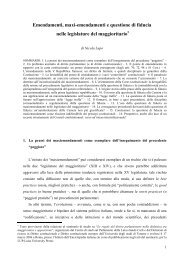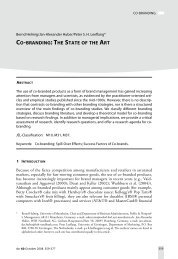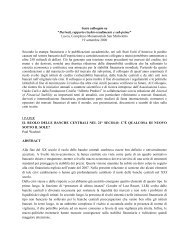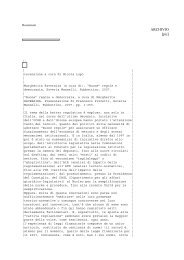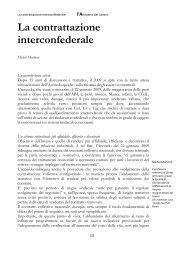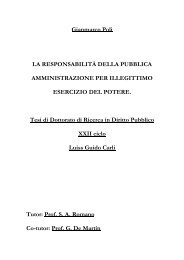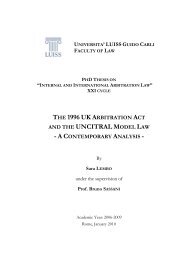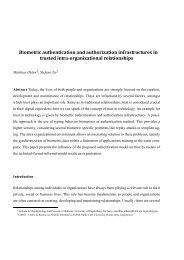The rebates, which consist in granting a lump sum discount to the ...
The rebates, which consist in granting a lump sum discount to the ...
The rebates, which consist in granting a lump sum discount to the ...
Create successful ePaper yourself
Turn your PDF publications into a flip-book with our unique Google optimized e-Paper software.
In <strong>the</strong> follow<strong>in</strong>g section are analyzed some of <strong>the</strong> ma<strong>in</strong> case law after <strong>the</strong> publication of <strong>the</strong>Guidance Paper <strong>in</strong> order <strong>to</strong> understand if and how <strong>the</strong> economic approach launched by <strong>the</strong> EuropeanCommission has <strong>in</strong>fluenced <strong>the</strong> antitrust assessment of <strong>rebates</strong> schemes.Tomra is <strong>the</strong> General Court’s first decision on loyalty <strong>rebates</strong> s<strong>in</strong>ce <strong>the</strong> Commission’s adoption ofan effects-based approach <strong>in</strong> its Guidance Paper on exclusionary conduct under Article 82 (nowArticle 102) <strong>in</strong> February 2009, followed by <strong>the</strong> decision on Intel <strong>in</strong> May of <strong>the</strong> same year.This two decision, as showed below, seem <strong>to</strong> disappo<strong>in</strong>t <strong>the</strong> effect-based approach proposed whit<strong>the</strong> Guidance Paper.2. <strong>The</strong> TOMRA decision<strong>The</strong> caseTomra is a Norwegian group active <strong>in</strong> <strong>the</strong> area of collect<strong>in</strong>g used beverage conta<strong>in</strong>ers. Its ma<strong>in</strong>activity <strong>consist</strong>s of <strong>the</strong> supply of so-called reverse vend<strong>in</strong>g mach<strong>in</strong>es (RVMs) that are used for <strong>the</strong>collection of empty dr<strong>in</strong>k conta<strong>in</strong>ers.Tomra had a very high market share: <strong>in</strong> <strong>the</strong> years before 1997 Tomra’s market share cont<strong>in</strong>uouslyexceeded 70 %. Tomra's market shares have exceeded 95 % <strong>in</strong> Europe s<strong>in</strong>ce 1997. In any relevantmarkets Tomra's market share was a multiple of <strong>the</strong> market shares of its competi<strong>to</strong>rs. Tomra's rivals,<strong>in</strong>clud<strong>in</strong>g those who had <strong>the</strong> potential <strong>to</strong> become strong competi<strong>to</strong>rs, were all small or very smallcompanies, with a very low turnover and very few employees.Moreover, <strong>the</strong>re was no substantial countervail<strong>in</strong>g buyer power <strong>which</strong> would have been able <strong>to</strong>challenge Tomra's dom<strong>in</strong>ance <strong>in</strong> any of <strong>the</strong> markets concerned. Tomra, <strong>the</strong>refore, is a dom<strong>in</strong>antundertak<strong>in</strong>g <strong>in</strong> <strong>the</strong> common market.<strong>The</strong> European Commission found that Tomra had abused its dom<strong>in</strong>ance through <strong>the</strong> use of contractsthat <strong>in</strong>cluded exclusivity provisions, quantity commitments and retroactive <strong>rebates</strong>. <strong>The</strong> GeneralCourt of <strong>the</strong> European Union (<strong>the</strong> “General Court”) upheld <strong>the</strong> Commission’s decision <strong>in</strong>September 2010.<strong>The</strong> Commission’s DecisionAccord<strong>in</strong>g <strong>to</strong> <strong>the</strong> Commission Tomra's strategy was based on a policy that sought <strong>to</strong> preserve itsdom<strong>in</strong>ance and market share through means such as:prevent<strong>in</strong>g market entry;keep<strong>in</strong>g competi<strong>to</strong>rs small by limit<strong>in</strong>g <strong>the</strong>ir growth possibility10



